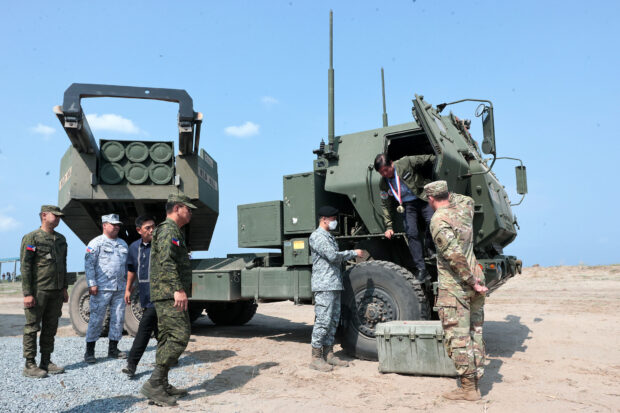Marcos watches as US-PH forces sink ‘enemy ship’

‘ALLIANCE IS ALIVE’ | President Ferdinand Marcos Jr., seen here alighting a truck equipped with US High-Mobility Artillery Rocket Systems, is the first Philippine leader in 12 years to attend the annual “Balikatan” exercises between the United States and the Philippines, in San Antonio, Zambales, on Wednesday, April 26, 2023. (Photo by GRIG C. MONTEGRANDE / Philippine Daily Inquirer)
SAN ANTONIO, Zambales, Philippines — President Ferdinand Marcos Jr. observed American and Filipino troops attacking and sinking a mock enemy ship in waters off this coastal town facing the West Philippine Sea, the first time in years that the country’s leader appeared at the “Balikatan” (shoulder-to-shoulder) war games between the United States and the Philippines.
From an observation deck at a Navy base here, Marcos used binoculars to watch as US and Filipino forces submerged their target — the Philippine Navy’s BRP Pangasinan, a World War II-era corvette decommissioned in 2021 — in an inland and coastal artillery bombardment and airstrike.
It was the first time in 12 years that the country’s president was present during the annual joint military drills, signaling tighter defense cooperation with its treaty ally in the face of China’s persistent encroachment in Philippine waters and harassment of local ships and fisherfolk.
The last time was on April 13, 2011, when then-President Benigno Aquino III attended a Balikatan event in Nueva Ecija province.
But Wednesday’s event faced a brief delay after an uninvited aircraft intruded into the country’s airspace.
Civilian ‘interloper’
The “interloper” was a civilian aircraft, according to Balikatan spokesperson Col. Michael Logico.
“We are not sure if it was intentional or accidental,” he said.
During the mock sinking event, Filipino and American troops, using their respective weapon systems, took turns firing at the decommissioned warship, which represented “an adversary force that is approaching by sea,” according to defense officials.
Drums tied together with a bamboo pontoon also served as smaller floating targets closer to shore.
The two allies targeted different parts of the ship to maximize the joint training until it eventually sank. In a real-life scenario, however, both would fire near the target simultaneously using multiple weapon systems, officials said.
The sinking of BRP Pangasinan was the main event of the largest-ever Balikatan exercises between Manila and Washington with almost 18,000 troops from both countries and Australia and the latest display of US firepower amid Beijing’s growing assertiveness in the region.
The President was joined by acting Defense Secretary Carlito Galvez Jr., National Security Adviser Eduardo Año, Armed Forces of the Philippines Chief of Staff Gen. Andres Centino, and US Ambassador to the Philippines MaryKay Carlson.
US Deputy Assistant Secretary of Defense for South and Southeast Asia Lindsey Ford was also in attendance.
Press Secretary Cheloy Velicaria-Garafil said the President was “hoping the country could benefit from enhanced cooperation with the United States,” highlighting the warmer relations between the two allies under the Marcos administration.
“According to Filipino and American military officials, the training event represented a tangible demonstration of the US-Philippine commitment to strengthen military capabilities and interoperability to meet shared modern-day security challenges,” Garafil said in a statement.
The Balikatan exercises, she said, provided “an opportunity for the two armed forces to enhance cooperation, increase capabilities and improve interoperability in conflict situations and disaster response.”
Sending a message
The 18-day exercises, which began on April 11 and will end on April 28, were held as Beijing issued repeated warnings over Manila’s decision to give American troops more access to local military bases under the 2014 Enhanced Defense Cooperation Agreement.
Among the weapon systems showcased during the live-fire exercise were the US High-Mobility Artillery Rocket Systems, considered integral to Ukraine’s defense against Russia.
Marcos himself boarded the truck for inspection before the start of the drills.
Other assets used for the sinking exercise were the Philippine Army’s Autonomous Truck Mounted Howitzer System and US Marine F-35B Joint Strike Fighters.
“The president came away with a deeper appreciation for joint and combined operations… He was deeply interested in how we operate together,” Logico said.
“The message we would like to send is that the alliance is alive and we are always challenging ourselves. One Balikatan is always going to be harder and more complex than the previous Balikatan. Every iteration you will expect something different,” he added.
Marcos, who will travel to the United States this weekend, earlier said he would seek specifics on Manila’s treaty agreements with Washington that need to “evolve” with changing geopolitical situations.
He will meet US President Joe Biden on May 1.
Fishers’ protest
In Masinloc town, some 77 kilometers from San Antonio, some 200 fishermen and their supporters in fishing boats staged a fluvial protest to protest the Balikatan drills.
Both towns face the West Philippine Sea, where tensions between the Philippines and China continue to escalate.
Manny De Jesus, president of Samahan ng Mangingisda in Masinloc, said his group was worried that the war games would have an adverse effect on fisherfolk and their families.
De Jesus said more than 1,000 “payao,” or fish aggregate devices, as well as coral reefs serving as fish habitats, might be damaged by the war games.
“We are afraid that these fishing structures will be damaged, along with the corals and reefs. Fish will surely be driven away by the explosions,” De Jesus told the Inquirer.
The Philippine Coast Guard imposed a “no-sailing zone” on at least five coastal towns during the Balikatan exercises.